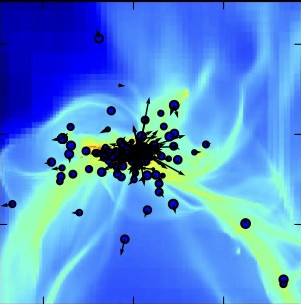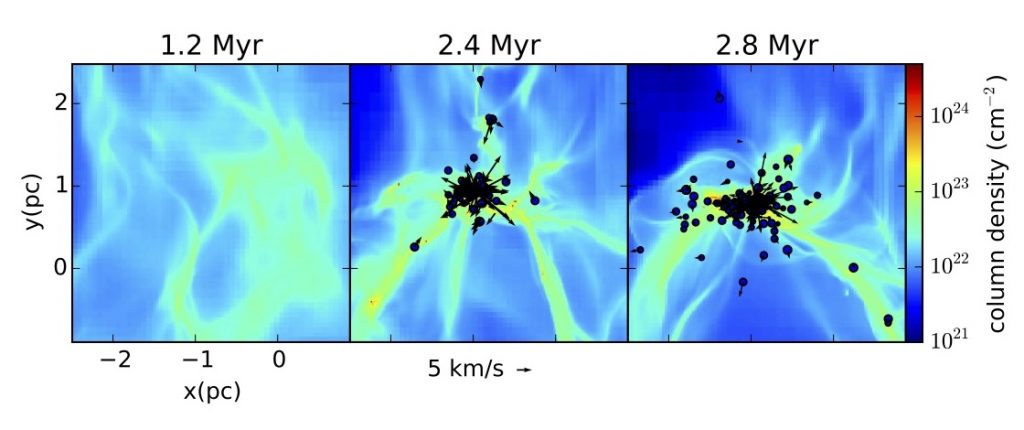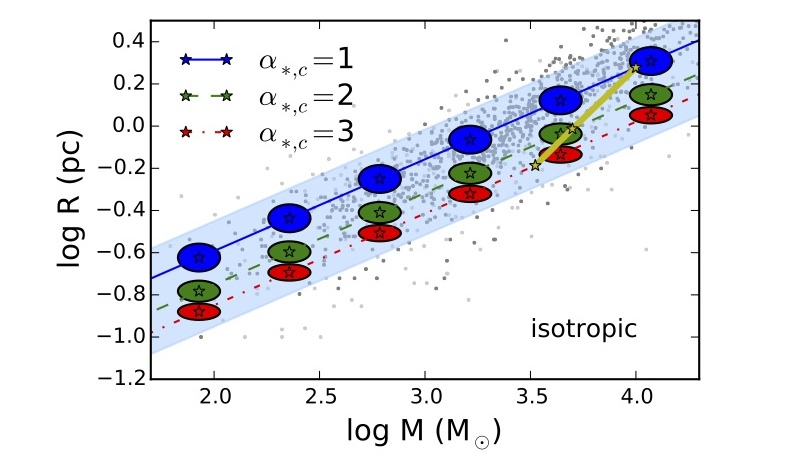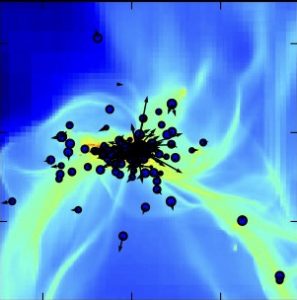Key role of the gaseous phase underlined by numerical simulations and analytical approach
The proto-clusters, which are the birth sites of stars, are formed non-uniformly inside molecular clouds of the interstellar medium. Studying the steps leading to the collapse of pre-stellar dense cores is essential to understanding the star formation. Using both numerical simulations carried out on massively parallel computers and an analytical approach, two researchers from the Astrophysics Department / AIM Laboratory of CEA-Irfu, Y.-N. Lee and P. Hennebelle, have shown that certain properties of a stellar cluster are determined before the star formation starts, especially in the gaseous phase and that the gravity and turbulence play a major role. This work, published in two articles in the journal Astronomy & Astrophysics, provides a better understanding of parameters related to star formation such as the initial mass function and their efficiency and rate.

Preliminary phase: the gaseous protocluster
Numerous numerical simulations of stellar cluster formation till recently have been carried out either with a whole molecular cloud at low spatial resolution or on a smaller part of the cloud. Indeed, limitation in computing powers made impossible to resolve both the dynamics at small scales while preserving the global movement at large scales, an effect that nevertheless has some impacts on star formation.
A series of new numerical simulations, with high resolution and adaptive mesh refinement, allowed the two researchers to show that a cloud initially close to equilibrium collapses under self-gravity and forms a star cluster at its center. It nevertheless indicates that a high density gaseous structure appears before the formation of the cluster and remains present during the evolution of the cluster. This gaseous phase, the proto-cluster, corresponds to star-forming clumps in the interstellar medium, regions of an intense activity of star formation measured by indirect methods since young stars are hidden by the gas. It is only in more advanced phases, when the residual gas is dispersed by the stellar feedback (after 3 to 4 million years), that one can observe directly the cluster. The gaseous proto-clusters have a typical size of the order of one parsec (3×1016 meters). The observation of the gaseous proto-cluster indicates that their mass is proportional to the square of their radius, for masses varying from one hundred to ten thousand solar masses. This is a remarkable property since proprocluster are the privileged region of the stars formation.

Numerical simulations show that the proto-cluster is in global “virial” equilibrium in which the turbulent and rotational energy of the medium are opposed to self-gravity. The stellar cluster inherits the energetic properties gaseous protocluster inside which it is formed.
Contribution of a simplified analytical model
By simplifying the physical mechanisms, an analytical model has allowed researchers to describe important elements of the physical mechanisms involved. The global collapse of the molecular cloud creates a central object whose mass is fed by continuous infall and turbulent movements. The rotation is greatly amplified by angular momentum conservation during the collapse. This gives rise to a turbulent, rotating, self-gravitating object under accretion. The simplified analytical model developed by the researchers nevertheless accounts for essential mechanisms and reproduces successfully the observed mass-size relation. By applying the obtained proto-cluster parameters to models of star formation, this work provides a encouraging explanation for the universality of the observed initial mass function.

The follow up of this study will be to integrate in the numerical simulations the feedbacks of stars, which modify their own environment by injecting energy and momentum. Various mechanisms, such as stellar wind, accretion radiation processes, ionizing radiation and supernova explosions, will allow to follow the evolution of the cluster more realistically.
Contact : Yueh-Ning Lee, Patrick Hennebelle
Publication :
« Formation of a protocluster: A virialized structure from gravoturbulent collapse
I. Simulation of cluster formation in a collapsing molecular cloud »
Yueh-Ning Lee and Patrick Hennebelle published in Astronomy and Astrophysics 591, A30 (2016)
DOI: https://doi.org/10.1051/0004-6361/201527981
Electronic version : http://arxiv.org/abs/1603.07942
« Formation of a protocluster: A virialized structure from gravoturbulent collapse
II. A two-dimensional analytical model for a rotating and accreting system »
Yueh-Ning Lee and Patrick Hennebelle published in Astronomy and Astrophysics 591, A31 (2016)
DOI: https://doi.org/10.1051/0004-6361/201527982
Electronic version : http://arxiv.org/abs/1603.07983
Rédaction : Yueh-Ning, Patrick Hennebelle, C. Gouiffès


